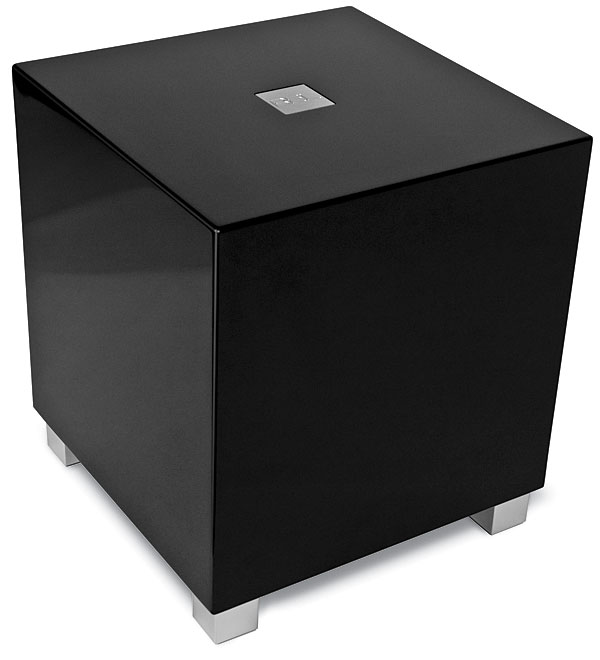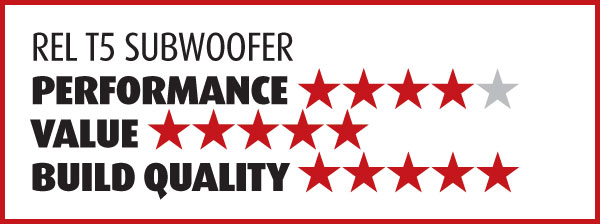REL T5 Subwoofer Page 3
Invariably, the less experience you have with this, the more likely you are to at first introduce too much low end. When it becomes annoying and relentless, as it surely will, you’ll back off the level to where you’ve introduced a hole. Eventually, you’ll hit the sweet spot (or the sweetest spot), and you’ll stop fussing with the subwoofer controls. Ironically, that point will be where you don’t hear the subwoofer, but you do hear its absence as a collapse of spatiality and physicality when it’s turned off.
In my room, the T5 and the Sonus Faber Toys blended nearly seamlessly. The sub’s upper frequency response subjectively overlapped the Toys’ lower limits with the speaker-level input set to nearly off. When I set it any higher, the sound screamed, “Subwoofer here.” When I flipped the on/off switch, the sound screamed equally loudly, “Where’s the bass?” That’s where you want it—at least after the room-shaking novelty wears off.
T5 Performance
Properly dialed in, the T5 performs for the most part as advertised. It produced clean, visceral, room-shaking bass on the submarine epic U-571. It did the same on The Hurt Locker, where the explosions play a key role—almost as punctuation marks do on the page. These effects become cartoonish if the subwoofer is turned up too high, and they lose some impact if it’s turned down too low. Here is where a larger sub that can provide greater output with lower distortion has the edge. Larger, more expensive subs (woofers, not marines) have less of an on/off quality, with a more graceful but equally adroit attack and a longer sustain and decay.

Music provided the T5 with its real test. The stereo SACD of Peter Gabriel’s So album incorporates prodigious deep bass on tracks like “Red Rain” and “Sledgehammer” that the Toys simply can’t reproduce running full range. With the T5 switched on, the bottom filled out nicely. If I set the crossover point too high, bloat resulted. When I set it too low, there was a discontinuity between the sub and the satellites, and the bottom end lacked harmonic structure and texture. Set properly, the software and hardware worked together seamlessly.
Next, I switched to the Rick Rubin–produced Johnny Cash CD American III: Solitary Man. It demonstrated that the sub/sat integration was sufficiently well dialed in to prevent Cash’s deep baritone from overexpanding and bloating in the lower registers. Yet, when I turned the sub off, it thinned out Cash’s voice, robbing it of weight and emotional authority.
The Bill Evans Trio SACD Waltz for Debby produced an impressive sense of the Village Vanguard’s cramped but recognizable space. Both Evans’ piano and Scott LaFaro’s bass were reproduced with satisfying, though not full, weight, and they were free of additive bloat and/or other bass colorations.
There’s no doubt that the honesty of the Toys’ frequency response helped the effectiveness of the sub/sat blend. These speakers don’t attempt to pump up the midbass to produce the sensation of deeper bass, thus improving the chances of getting good sat/sub integration.
Did the T5 Fool Mother Nature?
The REL T5 is a versatile, welldesigned, attractively built and finished compact subwoofer that succeeds at its main task: producing surprisingly deep bass that subjectively extended below 30 Hz in my room when sound effects and the occasional musical and/or spatial accent demanded it.
If you’re considering the T5, just remember that it will work best with satellites that have reasonably flat low-frequency response and that can be run full range without discomfort. To get the most from the T5, you should use the speaker-level input as well as the LFE channel input, even
if that means routing the cable through your basement or attic to get it across the room to the sub. Also remember that placement and level setting will be time-consuming and tricky and that, in the small subwoofer world, if you care about musicality more than bass, less is often more.
Finally, although the T5 is a very good product—and at $599, a good value as well—don’t ask it to do too much. Unless yours is a very small room, getting the real deal in terms of room pressurization and massive bass-wave launch capabilities requires more subwoofer than a single T5. Much as I’d like to report otherwise, this isn’t margarine, after all. There really is no fooling Mother Nature.





























































